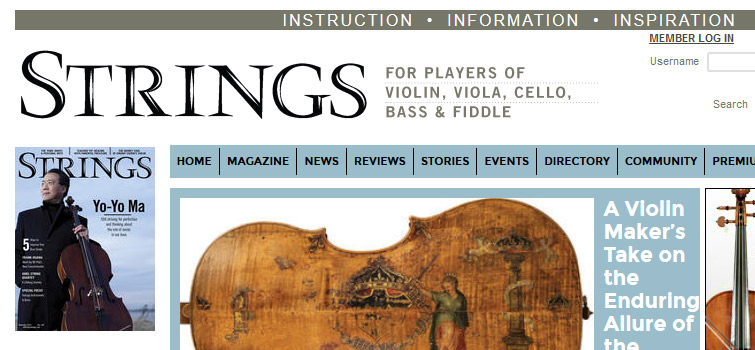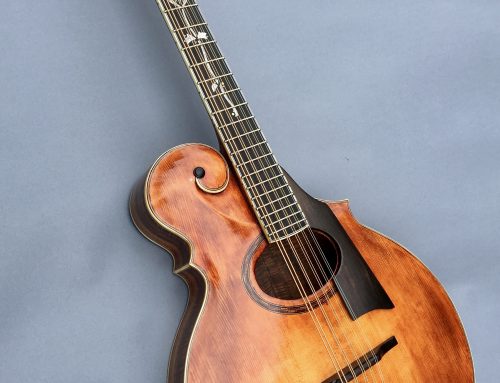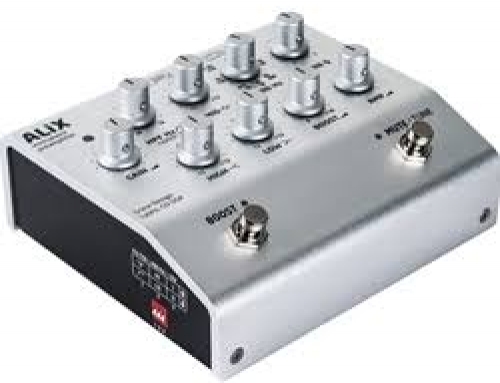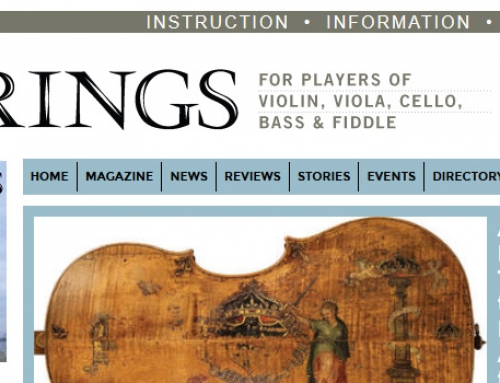From Strings Magazine September/October 1998
In this article, Darol reviews the NV violin.
 These days, there’s an embarrassment of riches in the multifarious and whimsical shapes available that can be played like a violin. Just about any form that can be fitted under the chin and bowed is now available to the adventurous fiddler. And the sound of these instruments is improving. The Zeta Strados, Tucker Barrett’s four-, five-, and six-string Luma and KoaLuma models, and Rich Barbera’s newest five string Acoustic-Electrics, to name a few, have taken electric-violin tone to impressive new levels.
These days, there’s an embarrassment of riches in the multifarious and whimsical shapes available that can be played like a violin. Just about any form that can be fitted under the chin and bowed is now available to the adventurous fiddler. And the sound of these instruments is improving. The Zeta Strados, Tucker Barrett’s four-, five-, and six-string Luma and KoaLuma models, and Rich Barbera’s newest five string Acoustic-Electrics, to name a few, have taken electric-violin tone to impressive new levels.
But here’s a tip about a new instrument that, tonally, is as far beyond other electric violins as a $40,000 modern instrument is beyond the factory fiddle you played in high school. Eric Aceto’s NV five-string electric violin, while at the high end of the price spread at about $5,000, is a must for the regularly performing professional violinist who absolutely has to play amplified and for whom tonal nuance is critical. Its builders have departed from conventional wisdom about amplified tone by envisioning the pickup and body as a dynamic unit, and by making changes in the body to modify the pickup’s sound. It is capable of tonal colors and a dynamic range much closer to an acoustic violin than any other electric I’ve ever tried. I believe it constitutes a quantum leap forward in electric-violin tone.
Using this violin, I have been able to go on stage with large electric bands on practically no notice, plug into a direct box, and play loud, open, acoustic-sounding fiddle with no additional EQ. The high strings, always a problem with electrics, sound particularly good on this instrument, with a natural openness, flexibility, and what I can only describe as “gravy”, that rich, dark punchiness that seems to add soul to whatever is played. This enables the player to get a presence and immediacy in performance or on tape that was never available in the past with anything less than an acoustic instrument and a microphone (a combination that unfortunately becomes useless when you’re playing with a really loud band).
The NV is the product of almost 20 years of research and development by violin and guitar builder Eric Aceto and his partner, Dan Hoffman, of Ithaca Stringed Instruments. (The company recently split off amicably from its parent, the well-known Ithaca Guitarworks, and is located at 6115 Mount Rd., Trumansburg, NY 14886; phone and fax
“I also do quite a bit of violin work here in the local recording studios,” Aceto says. “Working in all these different situations gives me a somewhat unique perspective on amplified violin. I will play a gig on a new instrument or a prototype, and the next day I’m in the shop talking with my partner Dan about how our latest changes have affected the instrument’s tone or response, or whatever we are currently focusing on.”
Aceto got his first electric violin early in his career, and his experience spurred him to think about how electrics could be improved. “I got a Barcus-Berry violin in 1973 and decided I didn’t like that sound, even though it was a milestone for the electric violin,” he says. Since there were few other options at the time, he decided to start building his own instruments.
And build he did. He once made a fiddle shaped like the cartoon character on a bottle of hot-pepper sauce. That model didn’t make it to market, but his other violins are ubiquitous. His pre-NV electric model was the popular Violect, which he still makes. With a graceful, slimmed violin shape, it has undergone continual refinement over the course of nine years–and it effectively led up to the NV’s creation. “When Dan Hoffman and I began to collaborate at Ithaca Guitarworks in 1989, we began developing what eventually became the NV,” says Aceto. “But before that, we worked very hard on the Violect, our flagship model for years. The Violect has a one-piece, routed-out back and sides. But the NV has a graduated top and back, and it’s built like an acoustic violin but with two major exceptions.” These are the missing f-holes and soundpost; twin tone bars support the top instead. A series of carefully drilled holes in a plastic side plate {which also holds the active electronics) tune the air cavity, further modifying the instrument’s tone.
Aceto says that it takes about two weeks to finish an NV, not counting varnishing. The company can usually deliver a new NV in eight to ten weeks, figuring in the usual backlog of orders. Most models have a spirit varnish, not lacquer. “But we’re now trying an amber oil varnish,” Aceto explains. “We enjoy going back to an older way of building, now that we’ve had so much practice.”
Electrics usually have five strings. “The only reason an acoustic violin can’t have five strings is that the body generally doesn’t handle it well,” explains Aceto. “You have problems favoring the low or the high string.” He feels that the new six-string violins take up too much space in his own musical ensemble work, but he adds, “I see no reason to limit the instrument to five if you have a use for more. I don’t consider more than four strings to be anything new. Just look at some of the pre-Baroque European viols: six, seven, nine strings, frets, sympathetics; it’s all been done before.”
I ask what accounts for the tone quality of the instrument and what they focused on to improve it. “The electric violin has always fallen down in the top end,” Aceto begins. “We asked, ‘Can the top strings be open, clear, and sweet?’ One can usually get an acceptable tone in the lower range. We really worked to get a good tone on the high strings.
“The normal violin is a highly perfected instrument. Its freely vibrating body tends to produce overly resonant rogue tones and feedback when you attach a pickup. With an electric instrument, you need to control and contain the sound. When amplified, this contained tone is more natural at the exaggerated volume levels. Also, there are some concessions to the fact of hearing a paper cone [in the amplifier speaker] moving air rather than the wood alone.” Thus, certain resonance-enhancing features, such as the f-holes, bass bar, and soundpost, needed to be eliminated to control tone effectively.
In a solid-body instrument, of course, these are all nonexistent factors, and though builders such as Tucker Barrett have made a subtle science of matching the solid body’s wood type with the pickup system, a semi-acoustic instrument can be a much trickier project. “The body resonance really affects the tone of the pickup,” Aceto says. The air chamber is tuned by carving, tapping, and listening, just as with an acoustic violin, then further finely tuned with side ports drilled in the plastic plate in the left-hand center bout. The tone bars, like twin bass bars, are positioned at angles, similar to those in a flat-back mandolin. The top uses a high arch so that the air cavity is comparable to that of a small viola.
Aceto and Hoffman seem to have evolved a smooth working style when it comes to the testing and development of the instruments they build. “I want to make clear just how much Dan has to do with these instruments,” says Aceto. “We both work on each instrument, and while I’m able to play it and focus on its performance capabilities, Dan intuitively incorporates my feedback into his end of things, which involves much of the construction, carving of tops and backs, and making of forms and jigs. I would say he’s my right hand but he’s left-handed, so I guess he’s more my left hand.” Asked how they tested the sound of the NV prototypes, Aceto replies that they tried them “on everything: a five watt mini amp, a Pendulum stereo preamp (a high-end unit, useful for live mixing of mics and pickups) into a studio mixing board, and a fancy Ithaca Guitarworks rig that included a Stewart power amp and Daedalus speaker cabinets. When you’re testing something, like the pickup or the resonance of the air chamber, the idea is not to make too many changes at once.”
The pickup is a vital factor in the success of the NV, and it developed out of work with Ned Steinberger and his NS model, a completely stripped-down violin in the spirit of his own famous pegheadless plastic guitars, which took the electric guitar world by storm in the 1980s and blew the instrument-design world wide open. Steinberger’s limited production NS is probably the most comfortable violin to hold and to play I’ve ever tried, amazingly light and utilizing a unique built-in shoulder rest. A trained engineer, Steinberger joined forces briefly with Ithaca Guitarworks in the early ’90s. “It was great to work with Ned,” Aceto says. “He’s very thorough and methodical and willing to rethink everything from square one. He inspired us.”
The factor that sets the pickup apart from others is the extent of its development as just one integral element in a system that includes the instrument’s body. “We used the L.R. Baggs pickup on the Violect and that worked best for us, but it still didn’t have the ‘distance from the strings’ sound. So we started over. The bridge bottom is made like a well, which the top part rests in. The top is a regular violin-bridge blank, easily replaceable. The bottom half, with the feet, has two replaceable piezo film elements. Any violin bridge works in a sort of X pattern, with no string having a direct path to the top. Lots of treble vibrations show up on the bass foot, and vice versa. So the positioning of the pickup was extremely important. Under the feet is too much body sound, further up is too much string.”
What about trying out my pet theory and just putting the pickup in the top, to get more wood sound? Aceto explains that in the soundboard, you’re liable to get too many stray harmonic nodes and weird vibrations. “Too much going on,” he says. “You are looking for a balance of that fundamental with all those overtones. Too close to the string, too tight. Too far from the string, not enough focus. I’m trying to hear the whole instrument and how each string is interactive with the others.”
Aceto and Hoffman have also worked hard to make the instrument attractive and comfortable. The NV that I tried was finished in a natural blonde color, and the workmanship was comparable to that of any good contemporary maker. The peghead sported a carving of an eagle’s head rather than a scroll. Aceto enjoys carving the pegheads, using his art school training, and has a large repertoire. “We’ve done a lot of oddball things over the years,” he acknowledges. “They include instruments with birds, beasts, and monsters for the pegheads.”
But for the two builders, it always comes back to sound. “I’m always amazed at what violins are capable of,” says Aceto. “I listen a lot: Heifetz, Grappelli, Stuff Smith, Ponty. I don’t know of a ‘perfect’ violin sound, but I like a sound with total clarity and penetration that doesn’t hurt your ears! So much comes from the player and their attitude. If the player believes in the sound, it’s there.
“As for who we see as our market, I feel that the instrument itself is really just a tool, a vehicle. It works for any and all musical situations where amplification is desired or necessary. Beyond that, the instrument grew out of a personal dissatisfaction with the existing electric violin technology. I guess I feel that it shouldn’t be a lesser instrument just because it’s an amplified instrument. Amplified violins have, for the most part, gotten a somewhat deserved bad rap because of the lack of dimension to their tone. A good acoustic violin is such a kickin’ axe that the difference in tone and response is very apparent when compared head to head with most of the electrics out there. It’s really a challenge to try to match that standard.”
“Dan and I just have been striving for an instrument that can deliver that visceral experience that inspires a musician to play in the elusive zone where music lives.”
Darol Anger







